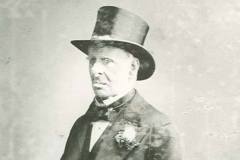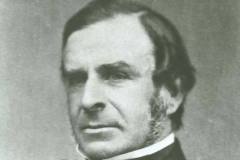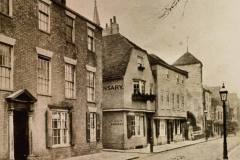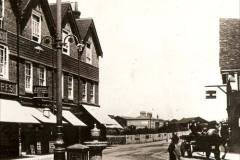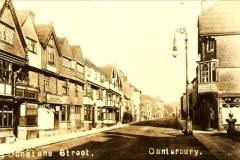Surgeon, Medical Pioneer & Sanitary Reformer
George Rigden (images 1,2) served the people of Canterbury for 63 years as the “Dispensary doctor”, treating the poor of Canterbury and promoting the welfare of all the city’s citizens.
- Rigden was born on 30 December 1815. His parents were Henry Minter Rigden (1792-1883) a farmer of Ratling Court, between Wingham and Nonington, and Judith, nee Elgar, (1791-1872). He was educated at Sandwich Grammar School and Chatham House Academy, Ramsgate. He was one of the first medical students at University College Hospital where he was awarded a silver medal.
- On 5 January 1837 the Court of Examiners at Apothecaries Hall granted him a certificate of qualification. Coincidentally, four days later Canterbury Dispensary opened in Watling Street, Canterbury, and Rigden was soon working there as a locum. The dispensary had been set up by voluntary contributions to “afford advice and medicines gratuitously to the sick poor and to attend them, when necessary, at their own houses”. In October 1837 the dispensary’s first house surgeon and secretary, Charles Bodenham Garrett, resigned – with the warm thanks of the governors for his work – and Rigden was appointed his successor. In September 1842 the dispensary, and Rigden, moved to Burgate Street (image 3).
- On 27 December 1843 Rigden married Imogen Masters the daughter of Alderman William Masters who ran an “Exotic Nursery” in Pound Lane – Rigden was rarely seen outdoors without a bright bloom in his buttonhole. The couple had nine children – two sons died in infancy and another son died later – he was survived by four sons, all in the medical profession, and two daughters.
- For many years Rigden compiled medical statistics for Canterbury using these to call for sanitary reforms. In an article in the British Medical Journal in 1869 he records 46 epidemics, from eight diseases, in the city over 30 years. At least 1,196 people died in these epidemics. Many of the dispensary’s patients lived in slum conditions near the river which was at times more like an open sewer and often flooded. But for a long time the city authorities baulked at the expense of a proper sewerage and water system and when Canterbury town council appointed its first Medical Officer of Health in 1873 Rigden lost out by 10 votes to 11 to Henry Hutchings the workhouse medical officer.
- Rigden pioneered the use of anaesthetics for childbirth and once nearly killed himself while experimenting with various substances. He also promoted vaccination and in 1870 was one of the first public vaccinators.
- In 1842 Rigden had employed James Beaney as a surgery boy and later as dispenser. When Beaney moved to Australia and made his fortune he did not forget his old teacher and in 1877 he sent a diamond ring to be presented to Rigden. Then in 1883 he sent a 100-guinea gold watch and, ever the showman, also sent £30 for a Champagne reception at the presentation.
- In 1887, to mark 50 years at the dispensary, Rigden, presented a drinking fountain to the city at the entrance to Station Road in St Dunstan’s (images 4,5). The five-foot polished granite fountain surmounted by an urn was supplied by J.E. Wiltshier, builder and stonemason of Stour Street, Canterbury. If the fountain was still there in the 1940s it was probably destroyed by an enemy bomb that severely damaged the junction.
- Rigden retired in 1900 to be succeeded by his son Brian. He moved to 30 St George’s Place where he died on 21 March 1904. He was buried in the family vault at St Gregory’s churchyard, Canterbury. His wife, who had been seriously ill for two months, died on the day of his funeral.
J.P.D.
Thanks to: Canterbury Library for images 1 and 2; Paul Crampton for images 4 and 5.
Sources: British Medical Journal; Census data; Kentish Gazette; Victorian Canterbury, by Audrey Bateman, Barracuda Books, 1991; Whitstable Times And Herne Bay Herald

